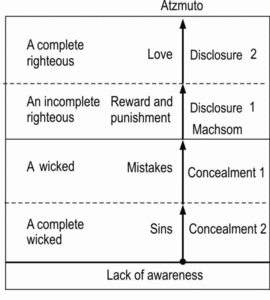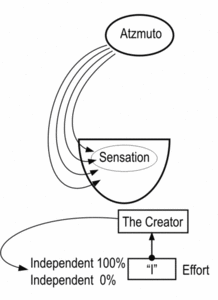Article "The Matter of Spiritual Attainment" - Lesson 4
-
Bold and in quotes: Original text of Baal HaSulam
-
Regular: Commentaries of Rav Laitman
-
lowercase italics: emphasized words
-
Capitalized italics: transliteration from Hebrew
We are reading from the book, Shamati, Article #3, page 8, paragraph: “Spiritual Attainment.”
Spiritual attainment is when the attaining and the attained come together...
Spiritual attainment depends on the Kelim (vessels) of the attainer: either he’s in corporeal Kelim, in which the intention is to receive, or he is in Kelim in which the intention is to bestow – and then he is in spiritual attainment. Corporeal or spiritual depends on the attainer and his intention.
The spiritual attainment is measured according to the degree of equivalence of form. Meaning, to the extent to which one can add his desires to his perception, to his attainment, however much of his desires are under the intention to bestow. Accordingly, he senses the attained in quantity and quality or, in other words, receives the Upper Light.
...as without an attaining there is no form to the attained since there is no one to obtain the form of the attained.
There's no one who can say that the attained exists if there’s no attainer.
Hence, this discernment is considered Atzmuto where there is no room for any utterance.
We can only say that there is a root that is unknown, unattained, not understood to our existence, to our attainments.
Therefore, how can we say that the attained has its own form?
We can only speak from where our senses are impressed with the expanding Light, which is “His desire to do good to His creations,” which actually comes into the hands of the receivers.
As we learn in this whole topic of perception of reality, that it’s all from the perspective of the attainer, attaining according to his senses, his properties, his equivalence of form to something that's outside of him. He doesn’t know what’s outside of him, but only perceives and attains a part of it according to the equivalence of form or lack of it.
Attainment according to the equivalence of form is called “spiritual attainment,” from the Machsom (barrier) up. Attainment according to the lack of the equivalence of form is called “corporeal attainment,” from the Machsom down. In such a case, he also perceives something in his senses, but not a part of that attained, but rather its opposite, because he is in opposite attributes, lack of the equivalence of form. Meaning, either “he who faults another does so through his own flaws” or, if you attain, then you attain according to your own corrections.
We should always distinguish between these two forms of attainment, and the laws of the two forms of attainment are not equal. Sometimes there is confusion among beginners when they read about perception, spiritual attainment. They take from there rules to their physical perception, which is where they are for the time being. We have to be careful of comparing the two, because what we receive before we cross the Machsom, we receive according to rules of inequivalence of form, not according to equivalence of form.
Lack of the equivalence of form is not how much is still missing in my equivalence, but on the contrary, it is how much I am not in equivalence. It isn't that the attainment is partial; it is completely incorrect, because the Kli itself is not calibrated in any way toward what is perceived. That is why what’s perceived is not the correct spiritual perception, but the corrupted forms of the receiver itself.
Question: What’s the difference between not perceiving the Creator below the barrier, and not perceiving Atzmuto after the barrier?
Below the barrier, a person is in two forms of concealment. If he’s laboring, he tries to relate everything that comes to him to the Upper Root, toward Atzmuto. Of course, he doesn’t know Atzmuto, he will never know It. But, if he tries with his efforts to relate what happens to him to one higher root, then accordingly he determines that he is in deficit of perception. It’s not that he lacks a certain measure of the real perception, but that he is in the opposite perception – a false one.
I don’t perceive a part of the complete attainment. Rather, I am in complete oppositeness of perception and in falsehood. It’s not that I have a quarter or a half of the truth, or some percentage of it; I have a falsity.
The attainer understands this by probing his own Kelim. He still hasn’t attained the term “the Creator” itself yet, because he is in concealment. He is either in double concealment, when he doesn’t feel the good that comes from the Creator and he doesn’t perceive Him as the one root for everything that happens to him. Or he is in single concealment, where he can already say that he still doesn’t feel the good, but he can somehow begin to ascribe everything that happens to him to one root. It’s not in the sensation, not in the attainment, but through some efforts of his own.
Past the Machsom, he begins to attain the Creator through reward and punishment, and then through love. Before the Machsom we have a double mistake (in double concealment), or a single mistake (in single concealment). Both are incorrect perceptions of the only term that we attain in the Creator. After the Machsom we have two forms of attainment: partial attainment (reward and punishment) or complete attainment (eternal love). That’s it.
We always speak about one term, with respect to which we measure our own state. That’s all there is, because there’s nothing more than the Creator and the creature. We measure the creature’s state according to the correction in his own Kelim. His Kelim might be doubly or singly corrupted, or doubly or singly corrected. Hence there are four states in which the creature can be: double concealment, single concealment, Machsom (barrier), above which there is reward and punishment; and eternal love.
We are speaking only from within the Kelim of the creature, so when we’re speaking about the Creator, we’re not actually talking about the Creator, but about how He is perceived by the creature. We’re always speaking either about the lack of correspondence or the measure of it. Before the barrier we speak about the lack of correspondence with the Creator, meaning how much I don’t attain, how much I’m opposite; above the Machsom, about the extent to which I am similar (to Him).
[Rav drawing] We learned that we have only double concealment, single concealment. In double concealment there are sins; in single concealment, mistakes; then follows reward and punishment in one disclosure, and love in double disclosure. This is what the creature has on its way. In double concealment we have a complete villain, in single concealment, a wicked; in single disclosure, an incomplete righteous, and in double disclosure, a complete righteous. It’s all according to the Kelim of the creature.
Question: I asked with respect to the discernment of Atzmuto, meaning beyond the Machsom with respect to Atzmuto.
With respect to Atzmuto there is nothing to check. Atzmuto is the root (see Drawing No.1). I can’t say anything about it. But outside of my sensations, I perceive within me these four states. Before that I was also in a state of unconsciousness, unawareness. It’s like people in this world: they are born, they live, they die, until the point in the heart awakens in them and then they begin to work.
That’s all there is. That’s what the creature perceives in its Kli. Also, there’s a root that designed the Kli of the creature that then projects something to this Kli, which the Kli senses. Then the Kli that senses, that attains, can determine the state it is in.
[Rav drawing] How does the creature know that it exists? Someone gives it a sensation that it does. That someone also gives it a sensation of how it exists. That someone gives it a sensation that there’s someone who sustains it, that someone designs these sensations in it.
How does the creature know this? The creature knows it through its own sensation. It gives a reason for its sensation, and that’s Atzmuto: someone before me. By designing me, so to speak, I begin to feel. What is prior to my sensation is called Atzmuto. I can’t feel it because it’s before my sensation. It designs it for me; He wants me to feel this way. This is why I can’t say anything about it; it’s the root for my perception.
Similarly, when we examine a table our sense of touch feels it as something hard and we also discern its length and width, all according to our senses. However, that does not necessitate that the table will indeed appear so to one who has different senses. For example, in the eyes of an angel, when it examines the table, it will see it according to its own senses. Hence, we must not determine any form in the eyes of an angel since we do not know its senses.
Thus, since we have no attainment in the Creator we cannot say which form the worlds have from His perspective. We only attain the worlds according to our senses and sensations as it was His will for us to attain Him so.
This is the meaning of “There is no change in the Light.” Rather all the changes are in the vessels, meaning in our senses; we measure everything according to our imagination. From this it follows that if many people examine one spiritual thing then each will attain according to his imagination and senses. Thereby each sees a different form.
In addition, the form itself will change in a person according to his ups and downs as we have said above, that the Light is Simple Light and all the changes are only in the receivers.
May we be granted with His Light and follow in the ways of the Creator and serve Him not in order to be rewarded but to give contentment to the Creator and raise Divinity from the dust. May we be granted adhesion with Him and the revelation of His Godliness to His creatures.
Why does Baal HaSulam end this way? First of all, these articles were usually said at meals or in all kinds of events, before an audience. Secondly, Baal HaSulam wants to say is that within the attainment of the Creator there is the personal participation of the creature. In this personal participation of the creature, the creature should discover how dependent it is upon the Creator.
[Rav drawing] The participation is very interesting. There is participation where, say, I have to attain something. In that, it is possible that I’m one hundred percent independent, or that I am zero percent independent.
Here, there’s a different issue. The creature attains the Creator; other than the Creator there’s nothing to attain. Everything he attains—the worlds, he thinks he’s in, all kinds of forms or something that exists in the worlds—he attains from the Creator and the Creator arranges the attainment for him. The creature should, according to his own efforts, find room for the effort in order to attain that he is putting hundred percent of his effort to open up to the Creator for bestowal, so as to reach the state where everything is controlled by the Creator.
Question: What’s the creature’s part in it?
The creature’s part is to discover – but it’s a great effort and its own effort – that the Creator leaves you room to discover that everything comes from one root. But the creature should discover that it comes from one root by its own effort. Before it exhausts its effort entirely, it cannot discover it.
That is, it seems to the creature that it exists in and of its self, and it is its own act, if he still doesn’t give one hundred percent of his efforts. There are two contradicting things here. When he can make all the effort that the Creator leaves him to do, in concealment, then he discovers everything that’s happening, and then there’s no more room for effort because “there is none else beside Him.”


